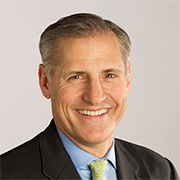 By John Hewko, Rotary International General Secretary
By John Hewko, Rotary International General Secretary
Innovation and flexibility. Those are two words you hear a lot today when we think about any organization adapting to a rapidly changing environment. But what do those two words mean for Rotary?
In short, they will define Rotary’s future, because they are fundamental pillars of our strategic plan for enhanced impact, reach, engagement and adaptability.
If we are really serious about growing Rotary and attracting new members from all demographics, we must innovate.
That innovation will need to take various forms.
It begins, first, with making the idea of innovation in Rotary a mindset. It begins with developing a culture of positive change and adapting to the needs of our new realities and challenges.
Second, innovation is also about transformative technologies. We can call this sustaining innovation – that is, constantly developing our suite of products to serve our existing members.
We have implemented this concept of sustaining innovation through three channels of new technology: Rotary’s Learning Center, Rotary Club Central, and an enhanced online membership leads program. Now, all these tools are at your disposal, and many new ones are in the process of being developed. Their consistent use should be a key foundation of our future growth strategy.
The third kind of innovation that we must aspire to generate at Rotary is called disruptive innovation.
In the world of business, it refers to a product or service, often very simple in its first design. This product or service takes root at the bottom of a market, and then relentlessly grows in popularity, until it displaces established competitors.
Think of how the traditional taxi cab business has been changed forever by ride sharing platforms such as Uber, which connects consumers who need rides with drivers willing to provide them.
With a growing group of individuals looking for connection, friendship, and an opportunity to get involved in the world around them, Rotary is well positioned to be a disruptive innovator.
“If we are really serious about growing Rotary and attracting new members from all demographics, we must innovate.”
Imagine for a moment what Rotary clubs could look like in the future. Clubs that could change their meeting schedule and format, can relax attendance requirements, and offer multiple membership types.
Think of a club where you can invite Rotaractors to be members of your club while they are still in Rotaract.
A club of the future, where measuring adherence to the rules is replaced with measuring progress against goals to improve the community and to grow the club.
Well, you don’t have to imagine very far, because these clubs already exist.
Next Rotary Generation Invercargill is a family-friendly club in New Zealand with fluid meeting times and venues. While attendance is encouraged, it is not compulsory.
The Rotary Club of Aruba systematically engages with its local Rotaract and Interact Clubs to ensure a smooth and natural transition into the Rotary club. As a result, half of the club members are former Rotaractors.
Then there are the so-called Passport clubs. Three years ago District 5180 in California began thinking about a club model that would be attractive to younger members who were not interested in attending weekly meetings or paying dues they could not afford.
The district chartered what they called a Passport club with 20 members in Sacramento, California. The club meets only six times a year with an optional social event in the month between meetings. In addition to attending the six required meetings, every year passport members must either contribute $1,000 to the Rotary Foundation OR do at least 40 hours of community service with Rotary clubs or other non-profits in the district.
This club has more than tripled its membership in three years.
A long-term sustainable growth strategy just doesn’t appear out of thin air. It requires a commitment to club innovation and flexibility; a commitment to best serving the specific needs of our communities as they evolve, and to incorporate Rotaractors into Rotary.
I challenge all of us to think out of the box, and to grow Rotary through new innovative club models and to try new approaches.
I’m confident that we will embrace the opportunities ahead of us through innovation, flexibility and thoughtful change.
https://blog.rotary.org/2019/02/21/how-do-we-innovate-at-rotary/
